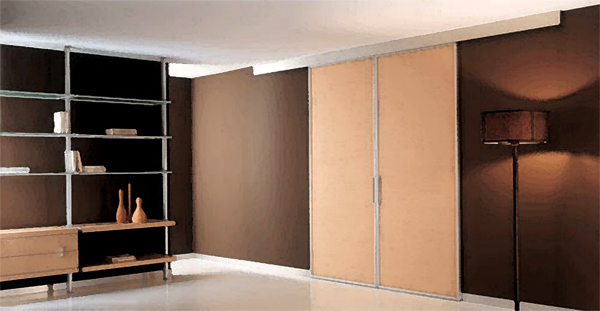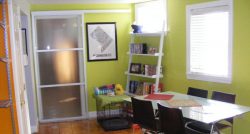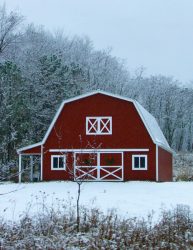
In the spirit of full disclosure, I’m not a fan of sliding barn doors. Don’t get me wrong, they’re perfect for sequestering horses where a tight seal isn’t necessary. But for homes? Barn doors may look hip and trendy, yet they just aren’t functional.
Domestic doors are meant to be solid, providing a sense of security and privacy. Even though they look normal. Sliding barn doors hang from an exposed track and don’t seal against the wall. Which means they let in noise and light. They rattle and don’t provide a convincing barrier.

The door in this image fits so loosely, a poster was added to the adjacent wall. Interestingly, the designer made no pretensions of privacy or seal, this door is fully translucent. Most designers however try for a tighter fit, rendering nearby walls and floors unusable for either furniture or artwork.
Every sliding barn door I’ve used was hard to operate and made a horrendous noise. I worried the door would skip the track. Sometimes it did.

Perhaps they’re called “barn doors” for a reason. Barns are utilitarian buildings, not fully heated or sealed against the weather. Quickly built with cheap materials, barns are places for hay and livestock.
Barns and their doors also remind us of a simple agrarian lifestyle. A mythical past, before modern technology complicated the world. Or they can invoke a similar utilitarian, warehouse aesthetic for the tragically hip urbanite. For these reasons sliding barn doors have seen a resurgence in the home building media.
But neither barns or warehouses are homes. In a winter storm I’d rather sit by the fire, safely behind a sturdy bulwark. When my teenage kids pump up the volume, I prefer a solid door instead of ear plugs.
Modern Barn Doors, watercolor adapted from Top Home Design (Flickr)
Red Barn photo adapted from Lady Dragon Fly CC (Flickr)
Sliding Door in Green Room adapted from Alex Ansley (Flickr)
